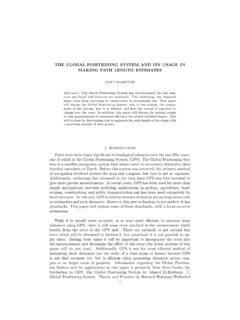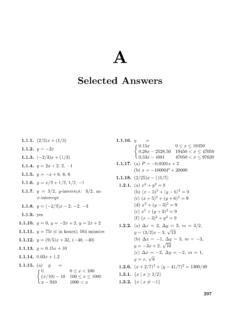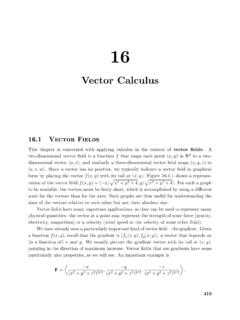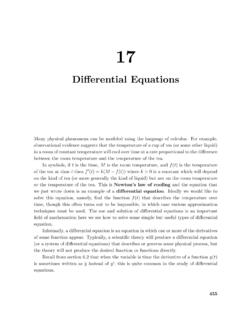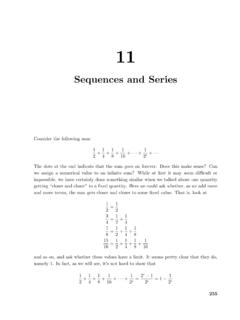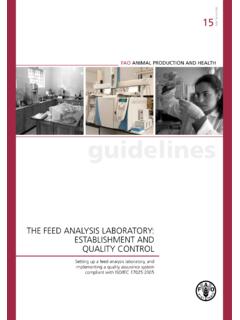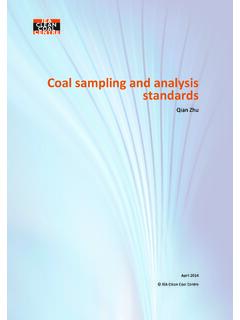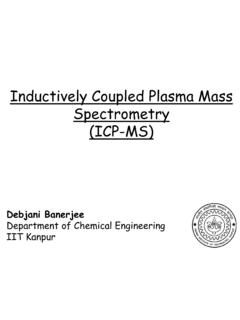Transcription of Chapter 3 Flame Atomic Absorption and Emission …
1 Chapter 3 Flame Atomic Absorption and Emission Spectrometry Introduction and History of AAS The first observation of Atomic Emission dates back to at least the first campfire where hominoids/humans observed a yellow color in the Flame . This color was caused by the relaxation of the 3p electron to a 3s orbital in sodium (refer to the energy level diagram in Figure given earlier), and in part by carbene ions. Slightly more advanced, but still unexplained observations were responsible for the first development of colorful fireworks in China over 2000 years ago. A few of the more relevant discoveries for Atomic spectroscopy were the first observations by Newton of the separation of white light into different colors by a prism in 1740, the development of the first spectroscope (a device for studying small concentrations of elements) in 1859 by Kirchhoff and Bunsen, and the first quantitative analysis (of sodium) by Flame Emission by Champion, Pellet, and Grenier in 1873.
2 The birth of Atomic spectrometry began with the first patent of Atomic Absorption spectrometry by Walsh in 1955. In the same year, flames were employed to atomize and excite atoms of several elements. The first Atomic Absorption instrument was made commercially available in 1962. Since then, there have been a series of rapid developments that are ongoing in Atomic and Emission spectrometry including a variety of fuels and oxidants that can be used for the Flame , the replacement of prisms with grating monochromators, a variety of novel sample introduction techniques (hydride, graphite furnace, cold vapor, and glow discharge), advances in electronics (especially microprocessors to control the instrument and for the collection and processing of data), and the development of Atomic fluorescence spectrometry.
3 Surprisingly, detection limits for the basic instruments used in Flame Atomic Absorption and Emission spectrometry have improved little since the 1960s but specialty sample introduction techniques such as hydride generation and graphite furnace have greatly improved detection limits for a few elements. Components of a Flame Atomic Absorption / Emission Spectrometer System Overview: The general layout of optical components for a Flame Atomic Absorption and Emission spectrophotometer is shown in Figure In FAAS, a source of pure light is needed to excite the analytes without causing excessive instrumental noise. Most instruments today use a hollow cathode lamp that is specific to each element being analyzed to emit a very narrow bandwidth of UV or visible radiation into the instrument for detection.
4 All modern and some older Atomic Absorption systems use double-beam technology where the instrument splits the beam of source light, with respect to time, into two paths. One of these beams does not pass through the sample and is used to measure radiation intensity and fluctuations in the lamp, while the other beam is used to measure the radiation that interacts with the analyte. The splitting of the source beam is accomplished with a chopper, illustrated in Figure where the chopper is in the reflection position in the center of the figure. The other half of the time, radiation is passed through the sample cell: in this case, the Flame that contains the atomized gaseous metal analytes. A portion of the metal atoms absorbs a specific wavelength of radiation (matching the wavelength emitted by the hollow cathode lamp) that results in a quantitative reduction in the intensity of radiation leaving the sample cell.
5 After interaction with the sample, or in the case of the reference beam bypassing the sample in the burner head, the beam of light is reflected by mirrors into the monochromator. This reflected light that contains various wavelengths past through a small slit that is size adjustable. Then it reflects off a focusing mirror to travel to the dispersing device (today a grating monochromator is used). Finally, the separated wavelengths of light are focused towards the exit slit with another focusing mirror. By changing the angle of the monochromator, different wavelengths of light enter the detector through the exit slit of the monochromator. The detector in older AAS units was photoelectron multiplier tube (PMT) that amplifies and converts the signal of photons to electrons that are measured as an electrical current.
6 Today various forms of advanced photon multiplying devices, described later, are used. An Emission spectrometer can be identical to an Absorption system except that no external light source is used to excite the atoms. In Flame Emission spectroscopy, the electrons in the analyte atoms are excited by the thermal energy in the Flame . Thus the sample is the source of photon emissions through relaxation via resonance fluorescence (Section ). Note that this results in Emission systems that are only single beam in design. Figure An Overview of a Flame Atomic Spectrophotometer. a) in detection mode where the source beam goes through the Flame sample cell; b) in reference mode where the source beam bypasses the sample cell.
7 One modern and very important component not shown in Figure is an automatic sampler. An automatic sampler is a device that is used to analyze numerous samples without the constant attention of an analyst. Modern automatic samplers can hold over a hundred samples. They can be used for most of the modes of FAAS and FAES. Instrument setup for running a set of samples with an automatic sampler is similar to the normal instrument setup: the correct lamp must be installed and aligned and the Flame must be lit and optimized with respect to burner height. Software and instrument settings may also need to be adjusted to ensure a smooth run of samples. Of course, automatic samplers require the use of a computer to both run the automatic sampler and collect the relatively large amount of data produced from various samples.
8 Automatic samplers greatly reduce the cost of analysis when large numbers of sample need to be analyzed for the same element. Usually an analyst will spend a normal day shift processing (digesting and diluting) samples. An instrument equipped with an automatic sampler can be set up at the end of the day and allowed to run all night without paying an analyst to manually run the samples or baby sit the instrument. In the morning, the analyst arrives with a collection of data to process. Optical Radiation Sources: For FAAS and FAES, the wavelengths of interest are in the UV and visible range. There are three basic types of radiation sources that are utilized in these instruments: continuous sources, line sources, and laser sources.
9 A continuous source, also referred to as a broadband source, emits radiation containing a broad range of wavelengths. A plot of intensity on the y axis and wavelength on the x axis is shaped like a broad Gaussian distribution with a few small peaks and shallow valleys. The Emission wavelengths of a continuous source can range over hundreds of nanometers. Examples of lamps considered to be continuous sources are deuterium, mercury, xenon, and tungsten lamps. These various lamps are used as background correction lamps (signal to noise correction devices) in AAS and AES instruments and not as source lamps for analyte detection. Line sources are lamps that emit very narrow bands of radiation, but this source of radiation is not as pure as radiation from a laser.
10 The most common line source radiation generator used in AAS is the hollow cathode lamp (HCL). A schematic of a calcium HCL is shown in Animation below. These lamps are encased in a cylinder made out of glass walls and a quartz end cap. Glass end caps can be used for visible wavelength emitting materials while quartz must be used for UV emitting HCLs. These cylinders are filled with a noble gas (Ne or Ar) to sub-atmospheric pressures of 1 to 5 torr. HCLs also contain a tungsten anode, a cathode composed of the metal of interest, and various insulators (usually made out of mica). Lamps containing more than one element in their cathode are also available but most FAAS and FAES instruments can only measure one element at a time.
